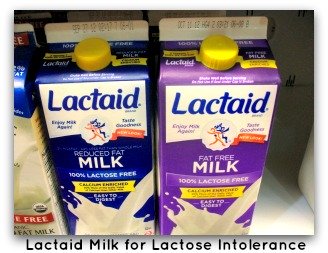- Home
- Lactose Intolerance
Lactose Intolerance
Symptoms of lactose intolerance include bloating, irritable bowel syndrome, diarrhea, cramps, gas, wind, reflux, gastro intestinal discomfort, belching, breathing problems, acid reflux, and flatulence. People with lactose sensitivity have trouble eating food that contain dairy. This includes different kinds of cheese, milk, ice cream, and cream.

Common Misspellings: lactose intolerante, lactose intoleranz, lactose intolerence, lactose intollerance, lacto intolerance, lactose intolleranz, lactate intolerance, lactoseintolerance, lactose intolorance
Milk sensitivity is a common occurrence among adults and children. As many as 75% of the adult world population may have a negative reaction to dairy products. This is called a sugar intolerance where there is a missing enzyme that causes the inability to metabolize or digest sugars. It is also known as hypolactasia or lactose deficiency.
Some people are more tolerant to milk than others. For instanace, some people can consume reduced-lactose products or a limited amount of lactose without showing any unpleasant signs. Sugar intolerance seems to affect African Americans, Native Americans, Asians, Hispanics, and Caucasians differently. Out of all the groups, U.S. Caucasians and people from Northern and Central Europe tolerate milk better. This group maintains lactase activity until adulthood making it possible to digest milk without annoying symptoms. But, For most humans, the amount of lactase in the intestine decreases with age which is a normal process called lactose maldigestion.
History tells us that 10,000 years ago, man had to feed their children the milk of their cows in order to survive from starvation. Only the people who possesed the genetic mutation could survive on that milk. As time went on, only this group had a selective advantage, These individuals who are the descendents of famine survivors experience normolactasia or lactase persistence, a condition where lactase is secreted into adult hood. (Steven Pray, 134).
Lactose intolerance is not an allergy as some people think. It is an intolerance that causes a negative reaction because of the sugar. On the other hand, protein, which is also found in milk causes allergies and sets off an immune response; how your body recognizes and reacts to bacteria and substances that appear to be harmful to the body.
Missing Lactase Enzyme
The reason people have so much difficulty digesting milk is because their bodies don't have enough lactase, the enzyme responsible for breaking down lactose, and turning it into glucose and galactose so it can be absorbed into the bloodstream. Lactose is the natural sugar/carbohydrate in milk. When this lactase enzyme is missing, intestinal bacteria works on and ferments the lactose causing digestive problems in addition to gas and bloating. We call this inability to metabolize or digest sugars a sugar intolerance.
Lactose Free Diets
It's possible to still eat the same kinds of food that contain milk by using milk substitutions. For recipes that require milk, instead try using more water. Other replacements for milk include coconut milk, almond milk, rice milk, tofu, sugar free yogurt, kefir, Lactaid and Dairy Ease. Intolerant individuals who eat yogurt may still develop minimal symptoms because yogurt is pasteurized. The pasteurization process removes the active cultures responsible for better digestion of lactose.
When people decide to totally eliminate milk and other forms of dairy from their diet they might find themselves missing some valuable vitamins and minerals. Dairy provides calcium and riboflavin, along with other essential vitamins like vitamin A, Vitamin D and the B vitamins. Without the proper amount of calcium a person can develop osteoporosis, colon cancer or hypertension.
For severe allergy suffers who are allergic to the protein in milk or those who are more lactose intolerant it's important to read food labels. Watch out for confusing ingredients in food that mean milk is in the product. Labels that say nondairy may still actually contain milk proteins whereas labels with dairy-free are safer and without any dairy. Parvae is a Kosher term meaning dairy-free and may be dependable term but there's always a chance dairy proteins can be found. Other confusing words to look out for are:
lactoferrin
casein
whey
butter (not including cocoa butter)
ghee
rennet
yogurt
lactulose
cream (not including cream of tarter)
nougat
lactalbumin
recaldent
Lactose Intolerance Test
A doctor can first take a patient's medical history into perspective when trying to reach a diagnosis for lactose intolerance. A hydrogen breath test can also be used in conjunction with medical history. A lactose challenge measures the retention (bloating) in the stomach after a 4 hour period. A lactose tolerance test involves drawing blood and taking blood samples while monitoring blood glucose. Using a skin allergy test where milk is applied to the skin and looked at for the formation of bumps may be helpful.
Lactose Intolerance Treatment
Lactose intolerance is not a disease although it is secondary to illnesses such as celiac, gastro intestinal surgery, and Crohn's disease. These conditions injure the mucosa in the intestine where lactase is secreted. Once these conditions are addressed, lactose digestion can improve.
Maldigesters can reduce or restrict lactose intake and use other means to assure proper calcium intake. While on the lactose free diet they can incorporate the milk substitutes mentioned earlier on this page. Also, some people who are intolerant to whole milk or pasteurized milk often do well on raw milk. Raw milk can be hard to find because certain laws have been impacted to ensure it does not reach store shelves. Pasteurization heats the milk up to high temperatures that kill the beneficial properties milk offers for better digestion. The milk is heated in an attempt to kill any harmful bacteria that some people believe causes sickness.
Lactose Intolerance In Infants
In a separate condition to lactose intolerance, infants who ingest dairy products without the capacity to metabolize galactose will develop a severe condition called galactocemia. This condition affects the brain and can cause retardation.
In a very rare inherited disorder at birth called congenital alactasia, some infants lack the lactase enzyme.
Infants allergic to the protein in milk, called cow's milk allergy, experience some of the same symptoms prevalent in lactose intolerant babies such as colic, gas, throwing up and mucos in stools. Symptoms of lactose intolerance are usually night awakenings, rashes, gas, diarrhea, colic and eczema. Infants can be put on a substitute diet maintenance program to get the nutrition they need when intolerant to milk. Often they are fed soy based formulas if they are not allergic to soy. You can find out more lactose intolerance information at foodallergy.org.
Return from Lactose Intolerance to Candida Counsel

Popular Articles


